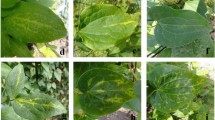Abstract
In this study, we describe the identification of a new gammacarmovirus infecting Cucurbita pepo plants showing a range of mosaic, stunting, yellowing, and wilting symptoms. The virus had a narrow host range and mostly produced chlorotic and necrotic local lesions in the majority of the tested plants. However, Nicotiana benthamiana showed systemic symptoms under laboratory conditions. Using a combination of Sanger sequencing and rapid amplification of cDNA ends (RACE), the complete genome sequence of the virus was determined to be 4274 nucleotides (nt) in length. Its genome organization is similar to that of members of the genus Gammacarmovirus in the family Tombusviridae, consisting of five overlapping open reading frames (ORFs) encoding p28, replicase, p7A, p7B, and coat protein (CP), respectively. The genome is flanked by short 5′ and 3′ non-coding regions (NCR) at either end. In pairwise comparisons of replicase and CP sequences, the virus showed the highest amino acid sequence identity of 71.55% and 54.86%, respectively, to melon necrotic spot virus (MNSV), the type member of the genus Gammacarmovirus. Since the sequence identity values are below the species demarcation threshold suggested by the International Committee on Taxonomy of Viruses (ICTV), the virus from Cucurbita pepo plants, for which the name "cucurbit carmovirus" (CuCV) is proposed, represents a new species. In phylogenetic analysis based on the replicase and CP amino acid sequences, CuCV clustered with MNSV but formed a distinct branch, further confirming that the virus is a distinct member of the genus Gammacarmovirus.


Similar content being viewed by others
Data availability
All the data generated or analyzed during this study are included in this manuscript and the supplimentary data has been attached and the complete genome sequence is deposited in NCBI database with an accession number JX879088 (https://www.ncbi.nlm.nih.gov/nuccore/440454716).
References
Ratnam N, Vandana N, Najibullah M, Ibrahim MD (2017) A review on Cucurbita pepo. Phytopathology 9
Khanal V, Wells H, Ali A (2021) High prevalence of three potyviruses infecting cucurbits in Oklahoma and phylogenetic analysis of cucurbit aphid-borne yellows virus isolated from pumpkins. Pathogens (Basel, Switzerland) 10(1):53
Kumari S, Nagendran K, Rai AB, Singh B, Rao GP, Bertaccini A (2019) Global status of phytoplasma diseases in vegetable crops. Front Microbiol 10:1349
Scheets K, White KA, Rubino L, Martelli G, Rochon DA (2015) ICTV taxonomic proposal 2015.007 a-rP divide the genus Carmovirus into three new genera: Alphacarmovirus, Betacarmovirus, and Gammacarmovirus. https://talk.ictvonline.org/ICTV/proposals/2015.007a-rP.A.v1.split_Carmovirus.pdf
Mackie J, Higgins E, Chambers GA, Tesoriero L, Aldaoud R, Kelly G, Kinoti WM, Rodoni BC, Constable FE (2020) Genome analysis of melon necrotic spot virus incursions and seed interceptions in Australia. Plant Dis 104(7):1969–1978
Genoves A, Navarro JA, Pallas V (2006) Functional analysis of the five melon necrotic spot virus genome-encoded proteins. J Gen Virol 87(Pt 8):2371–2380
Gopinath K, Dragnea B, Kao C (2005) Interaction between Brome mosaic virus proteins and RNAs: effects on RNA replication, protein expression, and RNA stability. J Virol 79(22):14222–14234
Argos P (1988) A sequence motif in many polymerases. Nucleic Acids Res 16:9909–9916
Kamer G, Argos P (1984) Primary structural comparison of RNA-dependent polymerases from plant, animal and bacterial viruses. Nucleic Acids Res 12:7269–7282
Thompson JD, Higgins DG, Gibson TJ (1994) CLUSTAL W: improving the sensitivity of progressive multiple sequence alignment through sequence weighting, position-specific gap penalties and weight matrix choice. Nucleic Acids Res 22:4673–4680
Kumar S, Stecher G, Li M, Knyaz C, Tamura K (2018) MEGA X: molecular evolutionary genetics analysis across computing platforms. Mol Biol Evol 35(6):1547–1549
Avgelis A (1985) Occurrence of Melon necrotic spot Virus in Crete (Greece). J Phtopathol 114(4):365–372
Chatzivassiliou EK (2021) An annotated list of legume-infecting viruses in the light of metagenomics. Plants 10:1413
Choi G-S, Kim J-H, Kim J-S (2003) Characterization of melon necrotic spot virus isolated from muskmelon. Plant Pathol J 19(2):123–127
Ohki T, Sako I, Kanda A, Mochizuki T, Honda Y, Tsuda S (2008) A new strain of Melon necrotic spot virus that is unable to systemically infect Cucumis melo. Phytopathology 98(11):1165–1170
Qu F, Morris TJ (1999) Carmoviruses (Tombusviridae). In: Webster RG, Granoff A (eds) Encyclopedia of virology, 2nd edn. Academic Press, New York, pp 243–247
Bos L (1981) Hundred years of Koch’s postulates and the history of etiology in plant virus research. Neth J Plant Pathol 87:91–110. https://doi.org/10.1007/BF01976645. Accessed 12 Oct 2022
Acknowledgements
This research was supported by the Department of Biotechnology, Ministry of Science and Technology, India (DBT) India, project code DBT/04/0404/2011/00070 and IPM-CRSP project code EPPA-A-00-04-000216-00/19276-425678.
Funding
Funding was provided by Department of Biotechnology, Ministry of Science and Technology, India (DBT) India, project code DBT/04/0404/2011/00070 and IPM-CRSP project code EPPA-A-00-04-000216-00/19276-425678.
Author information
Authors and Affiliations
Contributions
Author GK conceived and designed the work. NTN conducted the experiments, and DKN analysed the data and contributed equally to the work. The first draft of the manuscript was written by DKN and GK, and all authors commented on previous versions of the manuscript. All authors read and approved the final manuscript.
Corresponding author
Ethics declarations
Competing interests
The authors declare that they have no conflict of interest.
Additional information
Handling Editor: Massimo Turina.
Publisher's Note
Springer Nature remains neutral with regard to jurisdictional claims in published maps and institutional affiliations.
Supplementary Information
Below is the link to the electronic supplementary material.
Rights and permissions
Springer Nature or its licensor (e.g. a society or other partner) holds exclusive rights to this article under a publishing agreement with the author(s) or other rightsholder(s); author self-archiving of the accepted manuscript version of this article is solely governed by the terms of such publishing agreement and applicable law.
About this article
Cite this article
Neeraganti, D.K., Natra, N.T., Naidu, R.A. et al. Molecular characterization of a novel gammacarmovirus infecting cucurbits in India. Arch Virol 168, 65 (2023). https://doi.org/10.1007/s00705-022-05643-z
Received:
Accepted:
Published:
DOI: https://doi.org/10.1007/s00705-022-05643-z




